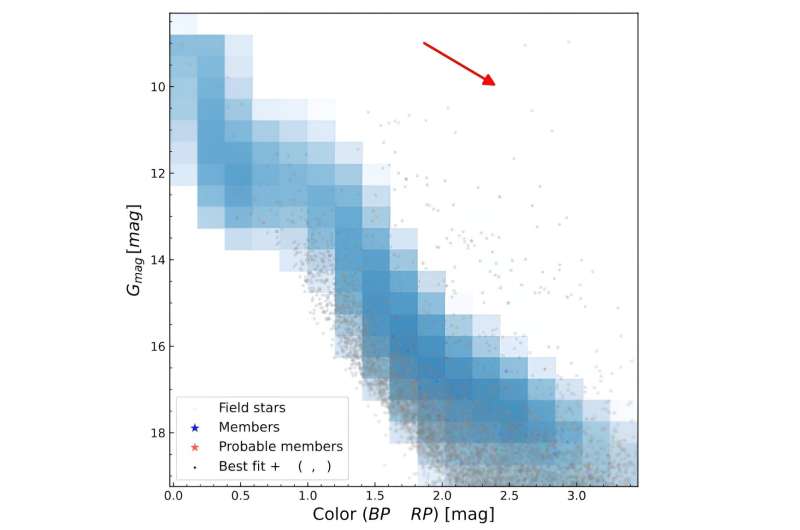
Using data from ESA’s Gaia satellite, astronomers from Chile have inspected a young open cluster known as NGC 6383. Results of the new study, presented in a paper published March 1 on the pre-print server arXiv, yield important insights into the properties of this stellar grouping.
Open clusters (OCs), formed from the same giant molecular cloud, are groups of stars loosely gravitationally bound to each other. So far, more than 1,000 of them have been discovered in the Milky Way, and scientists are still looking for more, hoping to find a variety of these stellar groupings. Expanding the list of known galactic open clusters and studying them in detail could be crucial for improving our understanding of the formation and evolution of our galaxy.
NGC 6383 is a young OC in the Carina-Sagittarius arm, within the Sh 2-012 star formation region. However, although the cluster has been known for many decades, many of its properties, including the exact age and distance, remain unknown.
That is why a team of astronomers led by Lucas Pulgar-Escobar of the University of Concepción in Chile, has analyzed the data from the Gaia Data Release 3 (DR3) and employed the Hierarchical Density-Based Spatial Clustering of Applications with Noise (HDBSCAN) algorithm, in order to unveil the parameters of NGC 6383.
“This study focuses on determining the characteristics of the young open cluster NGC 6383. To achieve this, the HDBSCAN clustering algorithm is utilized to identify potential cluster members based on proper motions and parallaxes from Gaia Data Release 3,” the researchers wrote in the paper.
Pulgar-Escobar’s team initially selected nearly 72,000 sources, searching for cluster members in the DR3 data. Finally, they included only sources with comprehensive parameters, narrowing the dataset to 16,640 sources, out of which 304 turned out to be member stars.
The results suggest that NGC 6383 is a very young cluster as its age was estimated to be between 1 and 4 million years. The distance to the cluster was measured to be about 3,600 light years.
The study found that NGC 6383 has a core radius of approximately 1.4 arcminutes, while its tidal radius is 29.33 arcminutes. The cluster’s center density was measured to be 10.48 stars/arcminute2. The metallicity of NGC 6383 is estimated to be at a level of 0.015 dex.
Summing up the results, the authors of the paper noted that more observations of NGC 6383 should be conducted, at expanding membership analysis. This could help get a more comprehensive cluster census, and integrate radial velocity data to explore cluster dynamics further.
More information:
L. M. Pulgar-Escobar et al, Bayesian characterization of the young open cluster NGC 6383 using HDBSCAN and Gaia DR3, arXiv (2024). DOI: 10.48550/arxiv.2403.01030
Journal information:
arXiv
© 2024 Science X Network
Researchers investigate the properties of open cluster NGC 6383 (2024, March 11)
retrieved 11 March 2024
from https://phys.org/news/2024-03-properties-cluster-ngc.html
part may be reproduced without the written permission. The content is provided for information purposes only.